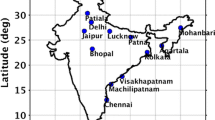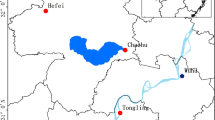Abstract
A validation study of the mesospheric and lower-thermospheric (MLT) wind velocities measured by the High-Resolution Doppler Imager (HRDI) on board the Upper-Atmosphere Research Satellite (UARS) has been carried out, comparing with observations by meteor radars located at Shigaraki, Japan and Jakarta, Indonesia. The accuracy of the HRDI winds relative to the meteor radars is obtained by a series of simultaneous wind measurements at the time of UARS overpasses. Statistical tests on the difference in the wind vectors observed by HRDI and the meteor radars are applied to determine whether the wind speed has been overestimated by HRDI (or underestimated by the MF radars) as previously noticed in HRDI vs. MF radar comparisons. The techniques employed are the conventional t-test applied to the mean values of the paired wind vector components as well as wind speeds, and two nonparametric tests suitable for testing the paired wind speed. The square-root transformation has been applied before the Mests of the wind speed in order to fit the wind-speed distribution function to the normal distribution. The overall results show little evidence of overestimation by HRDI (underestimation by meteor radars) of wind velocities in the MLT region. Some exceptions are noticed, however, at the altitudes around 88 km, where statistical differences occasionally reach a level of significance of 0.01. The validation is extended to estimate the precision of the wind velocities by both HRDI and meteor radars. In the procedure, the structure function defined by the mean square difference of the observed anomalies is applied in the vertical direction for the profile data. This method assumes the isotropy and the homogeneity of variance for the physical quantity and the homogeneity of variance for the observational errors. The estimated precision is about 6m s− for the Shigaraki meteor radar, 15 m s−1 for the Jakarta meteor radar, and 20 m s−1 for HRDI at 90-km altitude. These values can be used ot confirm the statistical significance of the wind field obtained by averaging the observed winds.
Similar content being viewed by others
Author information
Authors and Affiliations
Corresponding author
About this article
Cite this article
Hasebe, F., Tsuda, T., Nakamura, T. et al. Validation of HRDI MLT winds with meteor radars. Annales Geophysicae 15, 1142–1157 (1997). https://doi.org/10.1007/s00585-997-1142-7
Received:
Revised:
Accepted:
Issue Date:
DOI: https://doi.org/10.1007/s00585-997-1142-7




